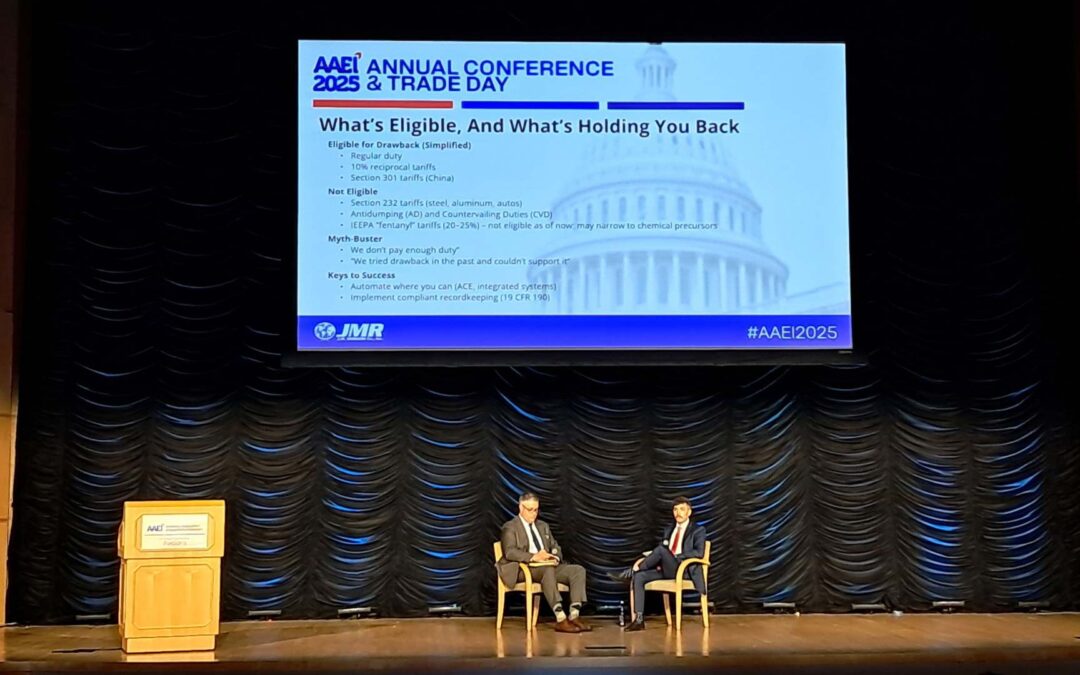At this year’s AAEI conference, J.M. Rodgers’ Andrew Galloway and Sean Dunne hosted a rapid-fire panel discussion focused on duty drawback in today’s shifting trade landscape. With tariffs continuing to impact the bottom line for importers and exporters, the session offered practical insights, real-world trends, and actionable advice for companies looking to recover costs through drawback. The full transcription below captures their candid take on where the opportunities lie—and how to get started.
Andrew Galloway:
I’ve been with the company for a little over 19 years. I head up sales and marketing operations, and I collaborate very closely with our duty drawback operational team. My role primarily centers around helping importers and exporters uncover drawback opportunities, guiding the handoff to our operational team for implementation, and supporting our clients throughout the lifecycle of their drawback programs. I often joke around and tell people I know drawback well enough to be dangerous, but I am not the resident expert. Thankfully, I’m surrounded by some incredibly smart and capable people here at JMR who bring a lot of technical experience to the table.
And I think with that, I have one of the experts with me here today—Sean Dunne.
Sean Dunne:
Good afternoon, everyone. My name is Sean Dunne. I am the Vice President of Drawback Operations at J.M. Rodgers. I’m here today to give a bit of an operational perspective and provide some best practices for steps you might want to take if you’re exploring implementing a drawback program.
Andrew Galloway:
Great. So I guess before we jump in, I just want to set the stage and give a quick overview of what we’re going to cover today. As many of you know and have already heard from several of our colleagues earlier, they may have provided more technical insights. You might hear some of the same topics repeated, but we’re here to offer a more practical, real-world perspective.
We’re going to focus on what’s changing, where the opportunities lie within drawback, and how companies are responding.
First, we’ll walk through what’s happening in the current trade and tariff landscape. As you’ve just heard, it’s changing pretty rapidly. We’ll look at how companies are trying to respond to that—it’s a very volatile environment right now, to say the least. We’ll also talk about which tariffs are actually refundable through duty drawback.
Next, we’ll discuss some real-life trends we’re seeing with several companies and how they’re using drawback as a way to mitigate costs and generate real recovery. Finally, we’ll talk a bit about how drawback can be used as a strategic tool. It’s a pretty fast-paced 20 to 25 minutes, and if time allows, we may do a Q&A.
I don’t think there is an official Q&A, but we’ll be available during the networking session afterwards, so feel free to track us down.
Alright. Let’s take a moment to look at what’s happening in the legal and political landscape. Tariff policy is currently being challenged, reinforced, and expanded—all at the same time. Just last month, the U.S. Court of International Trade ruled that certain tariffs imposed under AIPA were unlawful, stating that the imposed tariffs exceeded presidential authority. That ruling was immediately appealed by the government and went under review with the U.S. Court of Appeals.
On June 10, the federal court issued a stay, temporarily blocking the lower court’s ruling. Oral arguments are now scheduled for July 31. Just last week, on Tuesday, a group of small U.S. businesses petitioned the Supreme Court to take urgent action. The Court denied that request on Friday, meaning the case will proceed through the Federal Circuit for now. The takeaway? The tariffs remain in effect.
So nothing has really changed for us as importers and exporters—we’re still dealing with this. While trade attorneys might offer strong legal insights, I think the bigger takeaway is this: the Trump administration does not appear to be backing down from tariffs.
We’re seeing this play out in various ways. For example, targeted tariffs on semiconductors and pharmaceuticals are being discussed. Section 232 tariffs on steel and aluminum have doubled from 25% to 50%. President Trump continues to use tariffs as a primary negotiation tool with foreign trade partners. A new trade deal with China is reportedly “done,” although we haven’t seen the details yet. There’s also a framework for a new trade deal with the UK released last Friday.
Everyone’s watching for what will happen on July 9 when the 90-day pause ends. We’ll likely see extensions, new deals, and escalations—as seen with the breaking news involving Canada. It’s a waiting game at this point.
So while courts debate legality and we await breaking news, the practical reality for importers is clear: tariffs are here to stay, being enforced, and potentially expanding. Many believe the new baseline tariff globally will be 10%, with few trade deals lowering that.
That’s why so many companies are now actively trying to understand drawback—not as an afterthought, but as a strategic way to mitigate tariffs during this unpredictable time.

Sean Dunne:
To start, let’s do a high-level overview of which tariffs are eligible for drawback. Many of you are already aware, but there’s still a lot of confusion. I’ve received several calls from clients saying they heard tariffs aren’t eligible for drawback—which isn’t entirely true.
Confusion often stems from speculation in the news about potential new tariffs. While it’s good to stay informed, it’s more productive to react to executive orders and official customs messages rather than rumors.
As it stands today, many high-volume tariffs are eligible for drawback. These include:
- Duties under commodity classifications
- Section 301 tariffs from the Trump administration
- Reciprocal tariffs, typically around 10%
However, Section 232 tariffs on steel, aluminum, and auto parts—as well as the IPEF tariffs (also known as the fentanyl tariffs on China, Canada, and Mexico)—are not eligible.
If your company has duty exposure and you’re assessing whether you can support a drawback program, start by exploring your data and record-keeping. That’s the backbone of any successful program.
You need to understand the type of drawback you qualify for. For manufacturers, ask:
- Do I have access to an electronic bill of materials?
- What are my top duty-paid components?
- Do I have an ERP system that tracks inventory and production?
Also ask:
- Do I control my exports?
- Am I the importer of record?
- Do I have third-party cooperation?
If you import and export products in the same condition, consider if you qualify for unused direct identification or substitution. You’ll need to assess your export volumes (e.g., to Canada, Mexico, Chile) and whether your top duty-paid commodities fall into eligible categories.
Keep in mind that data requirements for direct ID are stringent. Ensure your broker retains product-level data, or that their reports are compatible with your ERP.
Get started early. Drawback allows claims up to five years retroactively, but first-time customs applications are lengthy. Procedural changes are easier to implement proactively than retroactively.
Andrew Galloway:
Thanks, Sean. Initially, we considered sharing specific case studies, but instead, we’ll highlight a trend we’re seeing across various industries—especially U.S. manufacturing companies.
These companies are importing raw materials, components, or parts, and many have historically paid little to no duty. For that reason, drawback was never on their radar—some had never even heard of it. I recently spoke to someone who asked me to explain drawback like he was in elementary school.
These companies are exporting large portions of their finished products—anywhere from 20% to 100%. Now, with new duty exposure, they’re seeing projected refunds ranging from $750,000 to over $3 million annually. One case is even projected at $78 million.
These aren’t large corporations—we’re talking small to midsize companies. Historically, larger companies brought more volume, but now these smaller firms are uncovering significant opportunities.
What we’re consistently hearing is that recovering duties through drawback isn’t optional—it’s necessary to remain competitive. Our job is to help them understand their supply chain, identify their drawback type, and guide them on data and documentation requirements.
Drawback is all about data—but documentation and record-keeping are equally important. Fortunately, many of these companies are starting fresh, so we can help them build strong programs proactively, rather than trying to clean up retroactively.
This isn’t just a manufacturing story—it applies to any company that exports. If you’re exporting, drawback should be on your radar. You might not always qualify, but you can seek guidance to see if you’re on the right path to recouping costs.
Sean Dunne:
As Andrew said, we’ve seen a lot of high-volume exporters who previously didn’t need drawback, and now their CEOs are asking them to become experts overnight.
If you’re tasked with exploring drawback, here’s a quick cheat sheet:
- Find the right resources – Trade compliance professionals supported by IT and possibly finance.
- Assess your exposure – Understand your top duty-paid commodities and where they fit into your supply chain.
- Understand your history – Has your company filed for drawback before?
- Map your data – Ensure your record-keeping is adequate.
- Align internally – Assign someone with operational knowledge and the pull to get the necessary information.
- Talk to an expert – Don’t self-disqualify. Any drawback broker can help assess your supply chain.
- Choose the right partner – Whether it’s someone with technical expertise or personalized service, pick a team that fits your business.
Andrew Galloway:
Just to close things out—this is a different trade era. Tariffs are affecting the bottom line. If you’re eligible for drawback, it’s a great way to recover costs.
We’re seeing a wave of new applicants. As Sean said, don’t wait. Application processes take time, and with more companies applying, we could see backlogs.
Start now—get your application in, build the right process, and support a compliant program. Talk to someone—whether it’s us or another provider—and see if you qualify.
Thank you to AAI for having us. We always walk away learning something new here, and we appreciate the chance to speak with all of you.
Thanks for sticking around to the end. Safe travels home.
Sean Dunne:
Thank you so much. That’s a wrap on our rapid-fire session.






